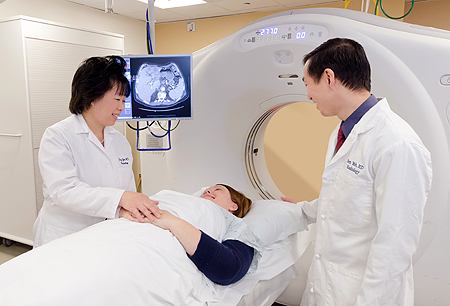Risk Reduction at UCSF
Low-Dose Protocols at UCSF Medical Center
UCSF uses CT settings (protocols) that adjust the dose of radiation depending on the patient age and size, the body part being imaged, and the reason for the study. These protocols are routinely reviewed for each body part. Specific protocols are used for pediatric imaging, which minimize dose. In addition, radiation levels for CT and Interventional Radiology procedures are monitored.
Strategies to Ensure Imaging Safety
UCSF’s Department of Radiology & Biomedical Imaging is fully committed to minimizing exposure to radiation for our patients and staff. Here are things we routinely do to ensure imaging is safe:
Choosing the most appropriate imaging study
Minimizing the exposure to radiation dose begins with the proper selection of an imaging study for the specific needs of every individual patient. Our radiologists work closely with and encourage referring physicians to consider tests that do not involve ionizing radiation (e.g., ultrasound or MRI) if these can provide the same information as a CT scan or other tests with ionizing radiation.
Latest CT technology for automatic radiation dose reduction
UCSF continually invests in dose reduction technology as it becomes available. Examples include the latest generation of automated dose modulation and CT image reconstruction software.
Optimizing exposure, “tube-on” time, and collimation
Dose reduction is achieved by reducing “tube-on” time and the amount of the body exposed to radiation. The “tube-on” time refers to the duration the X-ray tube is turned on and is often automatically modified during X-ray and CT exams and may be manually modified by the operator during X-ray, fluoroscopy, and interventional radiology procedures. Collimation is routinely used to carefully restrict the X-ray beam to the area of clinical interest.
Special attention to pediatric patients
Our team of dedicated pediatric radiologists works closely with pediatricians and pediatric subspecialists to minimize the use of ionizing radiation used to image children and infants, often recommending ultrasound (which does not use radiation) when indicated. When imaging using ionizing radiation becomes necessary, state-of-the-art radiation reduction techniques and low dose protocols (for CT) are employed.
Careful quality control
Quality control procedures are routinely performed to further minimize the potential risks of radiation and ensure that we are in compliance with all national standards for radiation safety. At the end of each exam that uses ionizing radiation, radiation dose measurements and compared to benchmarks for comparable exams. If measured doses for a particular exam exceed benchmarks, immediate notification of the appropriate staff responsible for overseeing radiation safety is triggered. All radiation-emitting equipment is also separately and regularly evaluated with testing equipment to ensure consistent safety and quality of radiological operation.
Training of technologists and radiologists
Ongoing education of all technologists and doctors in our department regarding the principles of ensuring “ALARA” (As Low As Reasonably Achievable) radiation dose is key to maintaining radiation safety and accreditation of our CT scanners from the American College of Radiology.
Radiation Protection Committee
The UCSF Department of Radiology & Biomedical Imaging maintains a Radiation Protection Committee that oversees radiation-intense protocols, radiological practice, and education regarding imaging algorithms to minimize patient and staff exposure to radiation when possible.

